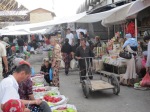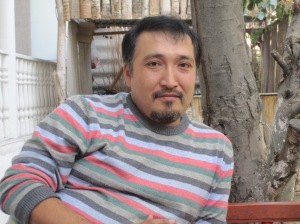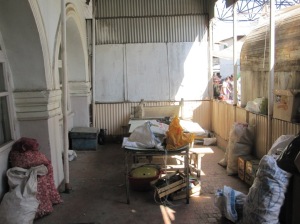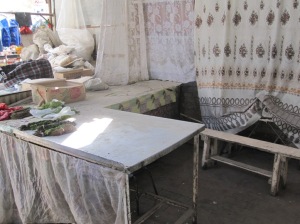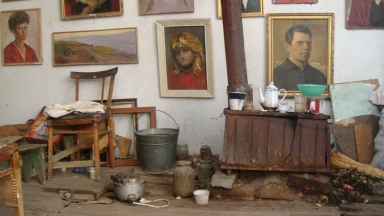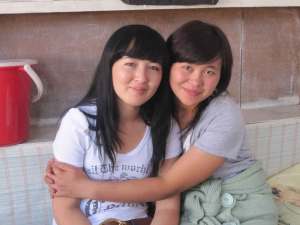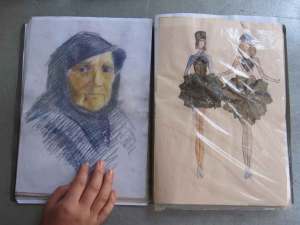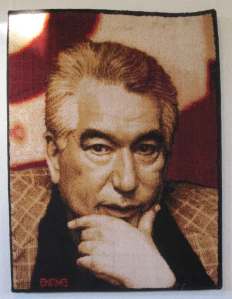There are some differences in the cultural practices of selling, handling, and eating meat in Osh, Kyrgyzstan and in California. For the most part Kyrgyzstan is a Muslim country and, though people drink vodka and beer, they tend to not eat pork. But keeping in mind that this is a multi-ethnic society, in the Central Asian bazaar, one can find pork, though usually relegated to a separate building or a corner somewhere.
From the perspective of Western culinary tradition, all meat in Central Asia is grass-fed and free-range. Meat in Central Asia is not industrialized. One example is that eggs and chicken tend to still be expensive because it is not mass-farmed, except for the ubiquitous frozen thighs imported from Brazil and the US. Interestingly we did meet some Americans living in Osh teaching locals how to raise chickens in more industrial style practices.
In Osh, if you go to the bazaar there is no real difference in the price of primal cuts of meat. Most people here will slaughter their livestock and sell it in pieces. For example a lambs leg will not be different by the kilogram than the rack. In other words, there is no hierarchy between different cuts of meat.
In Central Asia typically amongst the Kyrgyz and Kazakhs there is a high regard for the bones and what they represent to the familial hierarchy. These bones are cut and distributed during dinner to reaffirm this hierarchy. For example, the head of the lamb will go to the oldest or most honorable guest at dinner. The ear and tongue goes to children to mind their parents. The shanks goes to the mother in law. The breast goes to the son in law.
In California we regard the practice of making primal cuts in the tradition of western butchery. Western butchery though different in France, Britain, America and different parts of the world tends to follow a standardized selection of primal cuts. The butcher will receive the meat from slaughter houses after processing in large cuts generally half carcasses. Afterwards butchers make cuts of muscle groups like sirloin, top sirloin, round, brisket, shank, and rib. Subsequently, these large pieces of meat are cut down to the size that is appropriate for your dinner. This gives us the ability to choose our meat in a store, or restaurant and pay more for the choice cuts and less for those cuts not considered as good.
As for aging meat, Central Asians tend to sell meat when fresh. When storing meat they salt it with course salt and keep them in cooler spaces. One can see whole balconies in apartments with meat stored this way. In America and much of the western industrialized world, butchers age meat at least a few days up to nearly a month depending if they are “wet aged” or “dry aged”. The aging process keeps the meat from being tough and optimizing the flavor and giving the ability to cook meat “rare” or “medium rare.”
Working with local meats in Osh, although we could select cuts of the meat from the butchers, often we could not cook it the same way. For example, we selected some racks and sampled them at home by frying them on the pan. Though they tasted delicious, the racks were too tough. This influenced the way we would prepare the food in our restaurant. We tended to boil or braise our meats. Another difference is that in the west we tend to eat our meat on the rare side, or sometimes even raw. Here in Central Asia people will cringe at the site of a little blood and never eat meat raw.
 The bazar of Osh is rugged. Several narrow streets parallel the river; on the main thoroughfare we find mostly clothes, videos, bags, stationery… everyday stuff. Small sideways openings lead to other businesses; the covered meat market where everything is in plain sight, hooves, livers, severed bull’s heads, lamb fat and intestines. If you know where to look you can find a separate room ,with only one entrance door, where Russians sell pork and also a few very expensive chickens, the only ones not imported frozen.
The bazar of Osh is rugged. Several narrow streets parallel the river; on the main thoroughfare we find mostly clothes, videos, bags, stationery… everyday stuff. Small sideways openings lead to other businesses; the covered meat market where everything is in plain sight, hooves, livers, severed bull’s heads, lamb fat and intestines. If you know where to look you can find a separate room ,with only one entrance door, where Russians sell pork and also a few very expensive chickens, the only ones not imported frozen.
